Co-authored by Hiba Rehman and Sebastian Groundstroem
Looking for a little mid-winter teaching inspiration? In anticipation of the upcoming FFYE Forum Doing, Being, Becoming and Belonging – Spaces and Practices, we share here some practices and learnings from the Apple Foundation Program, an initiative run by Apple and UTS. The program is open for students from any faculty and runs Monday-Friday, for 4 weeks during the autumn/winter break. At other times, the program extends to high school cohorts, with a particular focus on equity groups. It is fully funded, and free for learners to take part.
The program is a fast-paced, hands-on experience where learners tackle real-world problems, design meaningful solutions, and build an app that matters – not just to themselves, but to their wider community. The main goal is to foster a positive learning experience and empower students to apply design thinking and problem-solving to these challenges, ultimately learning transferable, work-ready skills.
Here we explore the program through the lens of Doing, Being, Becoming, and Belonging – a powerful framework that helps us understand the deeper layers of learning and transformation that happen inside the classroom (Thompson et al., 2025, p52).
Doing: The role we play as guiding resources
We frame mentors in this program as guiding resources, not teachers. Our learners are the authors of their own learning journeys, so rather than delivering instructions, mentors create an environment where students take ownership of their growth and development. They have the autonomy to choose the problems they solve, the design decisions they make, and which feedback to embrace. This shift in power from teacher to learner nurtures agency, curiosity, and initiative.
When students are trusted to lead their own learning, surprising outcomes often emerge. They push boundaries, exceed expectations – and, in many cases, teach us something new in return. A clear example of this can be seen during the ‘Lotus Blossom’ rapid ideation exercise, where learners are challenged to generate 64 unique app ideas as a group, under tight time constraints. Without fail, the first reaction we hear is: “How can you expect us to come up with 64 app ideas?”
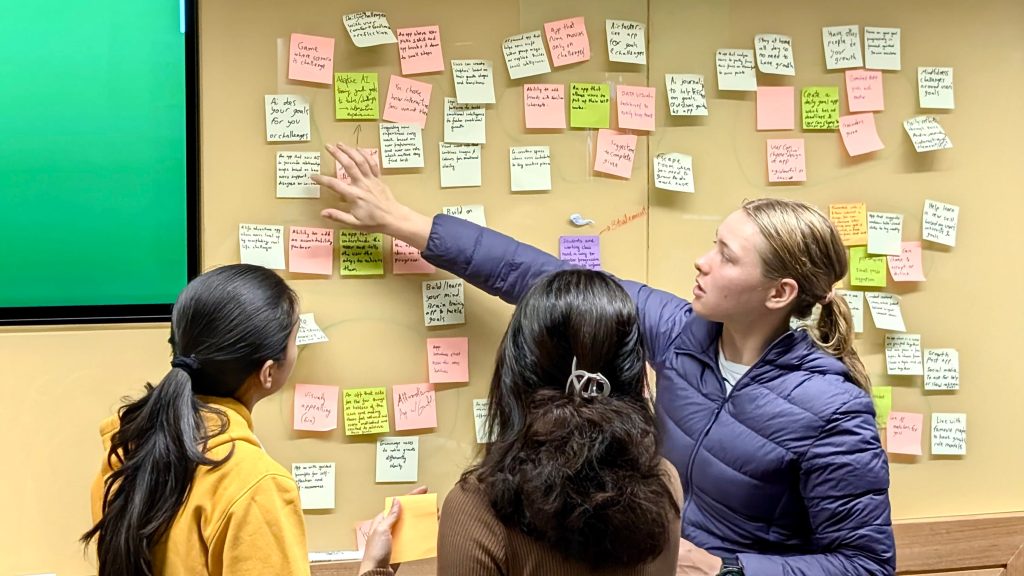
The ‘Lotus Blossom’ exercise where learners from UTS cohort 7 are seen creating, discussing & sharing 64 App ideas.
That’s when the real learning begins. As mentors, we lean into this uncertainty with a mindset of open, non-judgmental brainstorming. We remind learners that no idea is a bad idea – that even something like “An app for pet chicken owners to decorate eggs and share them to a local leaderboard” counts. The more unexpected, the better!
When we model vulnerability and creative risk-taking, learners feel safe enough to do the same. Almost every time, the groups end the activity surprised by the number of ideas they were able to generate, simply by trusting the process and being patient with their thinking. It is through doing – through active engagement, choice, and expression – that students begin their journey.
Being: encouraging self-expression through being an example
The tone for this learner-led approach is set from the beginning with a warm welcome and energising introduction from lead design mentor Sebastian Groundstroem. When mentors lead with authenticity, vulnerability, and genuine enthusiasm, they model the behaviours we hope to see in our learners. It gives students permission to show up, not just as participants, but as creators, collaborators, and decision-makers. They grow through being – by experimenting, reflecting, and developing confidence in a space that values progress over perfection.
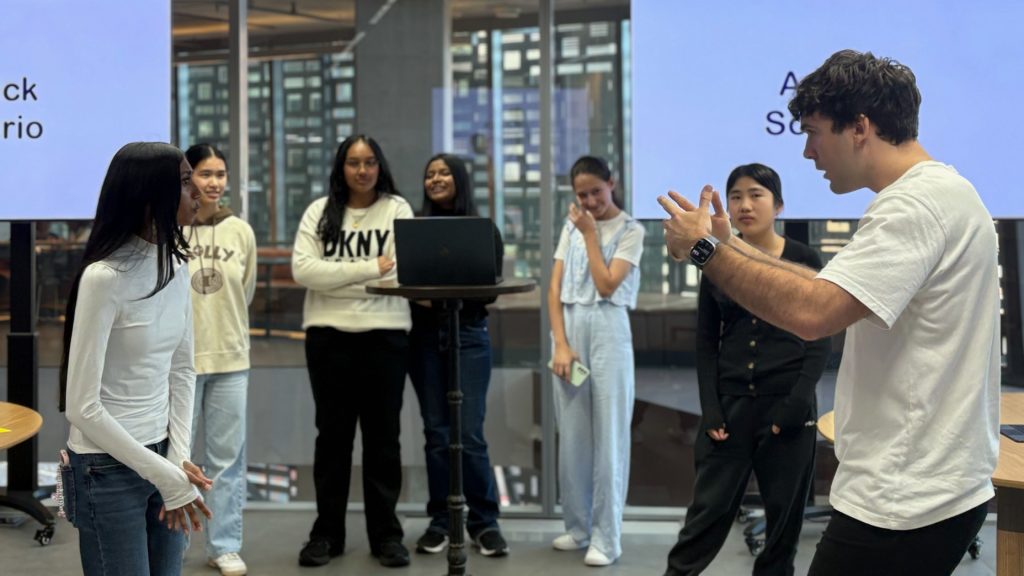
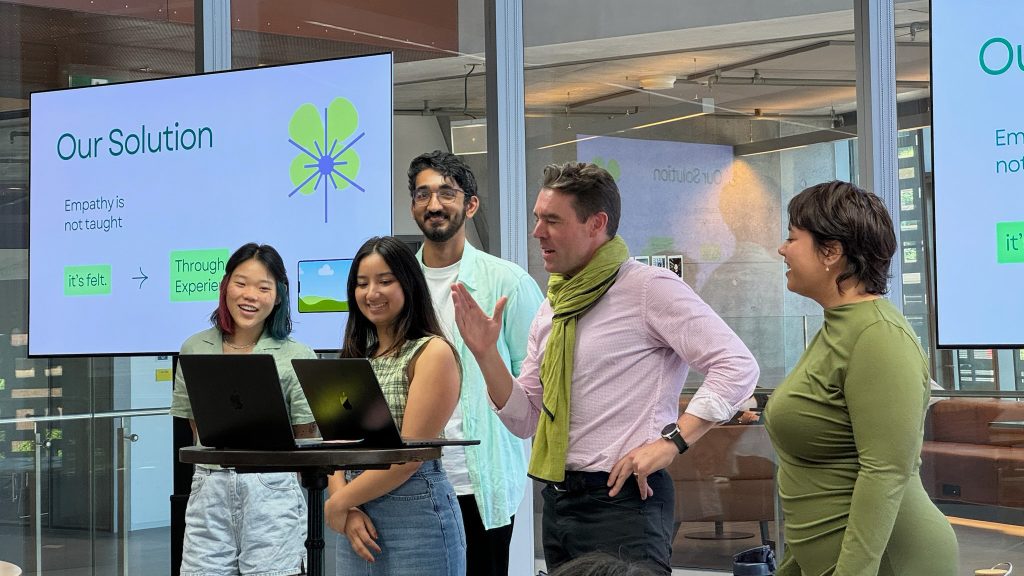
L-R: Sebastian Groundstroem acting out a scenario with a student from East Hills Girls Technology High School during a presentation; UTS Startups Cohort presenting their final App solution ‘Empathy Health+’
This philosophy is embedded in the curriculum and how it evolves; the program is continually refined using research-led insights to meet the needs of each cohort. If students demonstrate strong workshop performance and an ability to respond to feedback quickly and thoughtfully, mentors integrate more advanced design critiques to deepen their thinking. For cohorts struggling with early UX concepts, we introduce supportive tools such as Generative AI to assist in user persona development, prototyping, and synthesising research.
Becoming: embracing challenges with confidence
In this program, becoming is about empowering learners to tackle real-world challenges with creativity and confidence. At the heart of our curriculum is Apple’s Challenge-Based Learning (CBL) framework, designed to help learners explore and address personal, community, and global issues through inquiry and action. Students are prompted to identify a ‘Big Idea’ they care about, which can be topics that range from mental health and sustainability to aged care, animal welfare, or humanitarian aid.
Learners build foundational skills in design thinking, user experience, and resilient learning – but the real transformation happens when they collaborate with peers from different disciplines, interests, and life experiences to create a meaningful digital solution together. The structure of the program mirrors the intensity of industry: full-time attendance, tight deadlines, fast-paced ideation, and continuous collaboration. In this environment, learners develop more than technical skills; they build transferable capabilities like communication, prioritisation, adaptability, creative problem-solving, and leadership.
Belonging: challenging the myth of the ‘lone’ designer
Belonging is at the heart of everything we do. We challenge the outdated notion of the lone genius designer or coder by cultivating a space where collaboration, inclusion, and shared purpose thrive. Every learner enters the program with a unique perspective, shaped by their background, culture, and lived experience. We embrace these differences – not as challenges to overcome, but as strengths that enrich the learning process. In doing so, we help learners see the value in their own voice and in the voices of others.
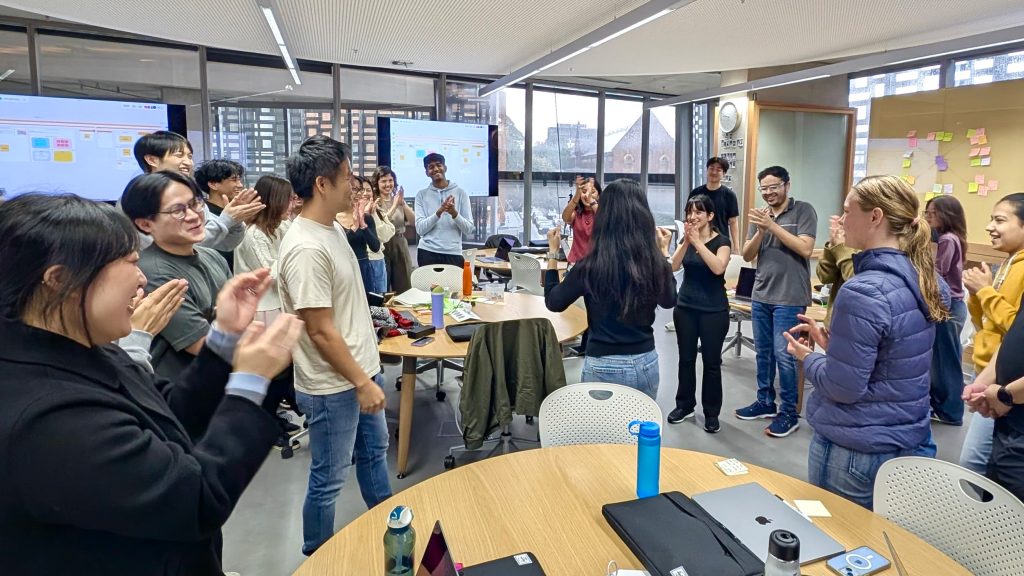
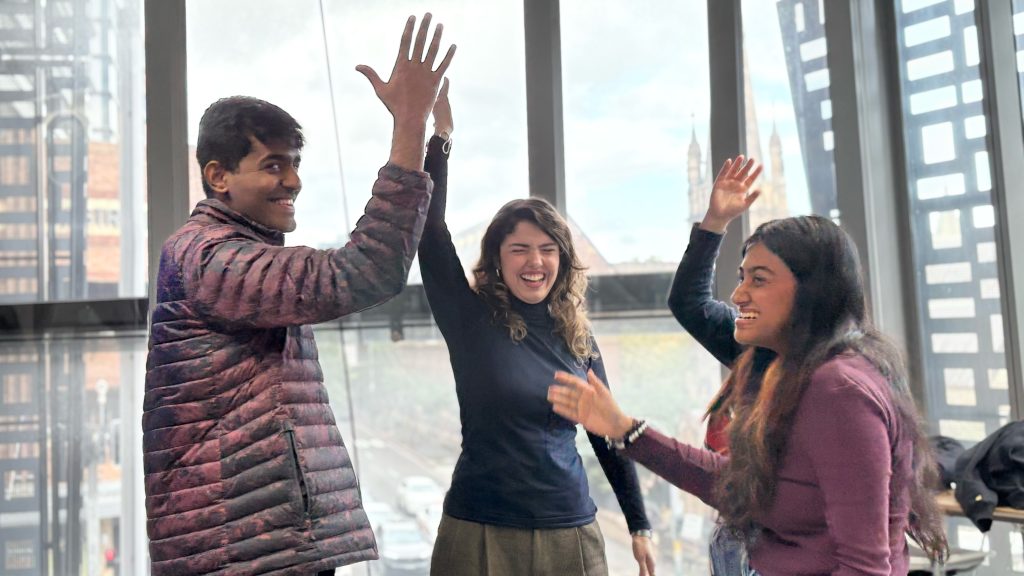
L-R: Learners cheering each other on during a ‘Hype Man’ game to set the high-energy tone for the day; Learners from our UTS Cohort 7 engaging in the team handshake exercise.
To break down barriers early on, each team creates their own identity – complete with a team name, handshake, motto, rules, and learning goals. This might sound playful, but it’s deeply intentional. These rituals set the tone for the next four weeks, building trust, accountability, and team cohesion. Throughout the program, we emphasise the importance of peer learning and shared growth. While technical skills can be developed individually, life-long, transferable skills like empathy, teamwork, and leadership are forged in community.
The Apple Foundation Program is a living example of what education can be when we prioritise Doing, Being, Becoming, and Belonging. It’s a space where learners are not just taught, but trusted. Where creativity is nurtured, challenges are welcomed, and community is built. We invite educators, mentors, and institutions to explore how this framework can inform your own teaching practice. Let’s move beyond traditional models and build learning environments where students don’t just participate – but thrive.
Interested to know more?
- Join the conversation at the upcoming FFYE Forum: Doing, Being, Becoming and Belonging – Spaces and Practices (23 June)
- Follow the Apple Foundation Program on LinkedIn
- Read more about the Apple Foundation Program on the UTS Website
- Further reading: Thompson, J., Mahat, M., Tregloan, K., Rivera-Yevenes, C., Lomer, S., Cockayne, H., & Zhang, A. Y. (2025). Exploring the meaning of campus through lived experiences of students, staff, and visitors. Higher Education Research and Development, 44(1), 49–67.
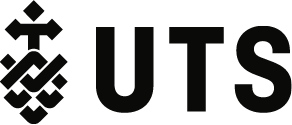
Fantastic work and amazing experiences for all! Thanks for sharing 🙂